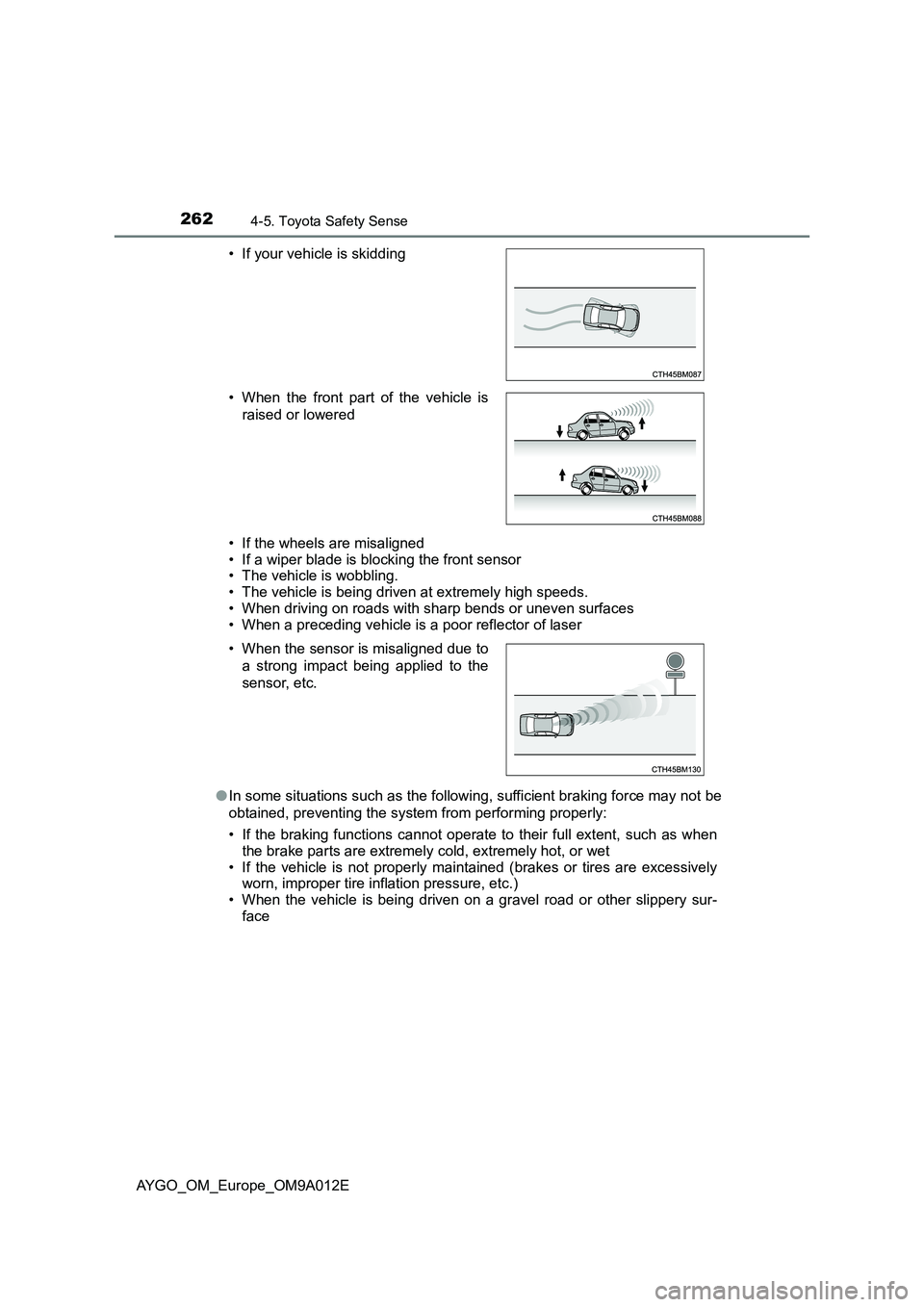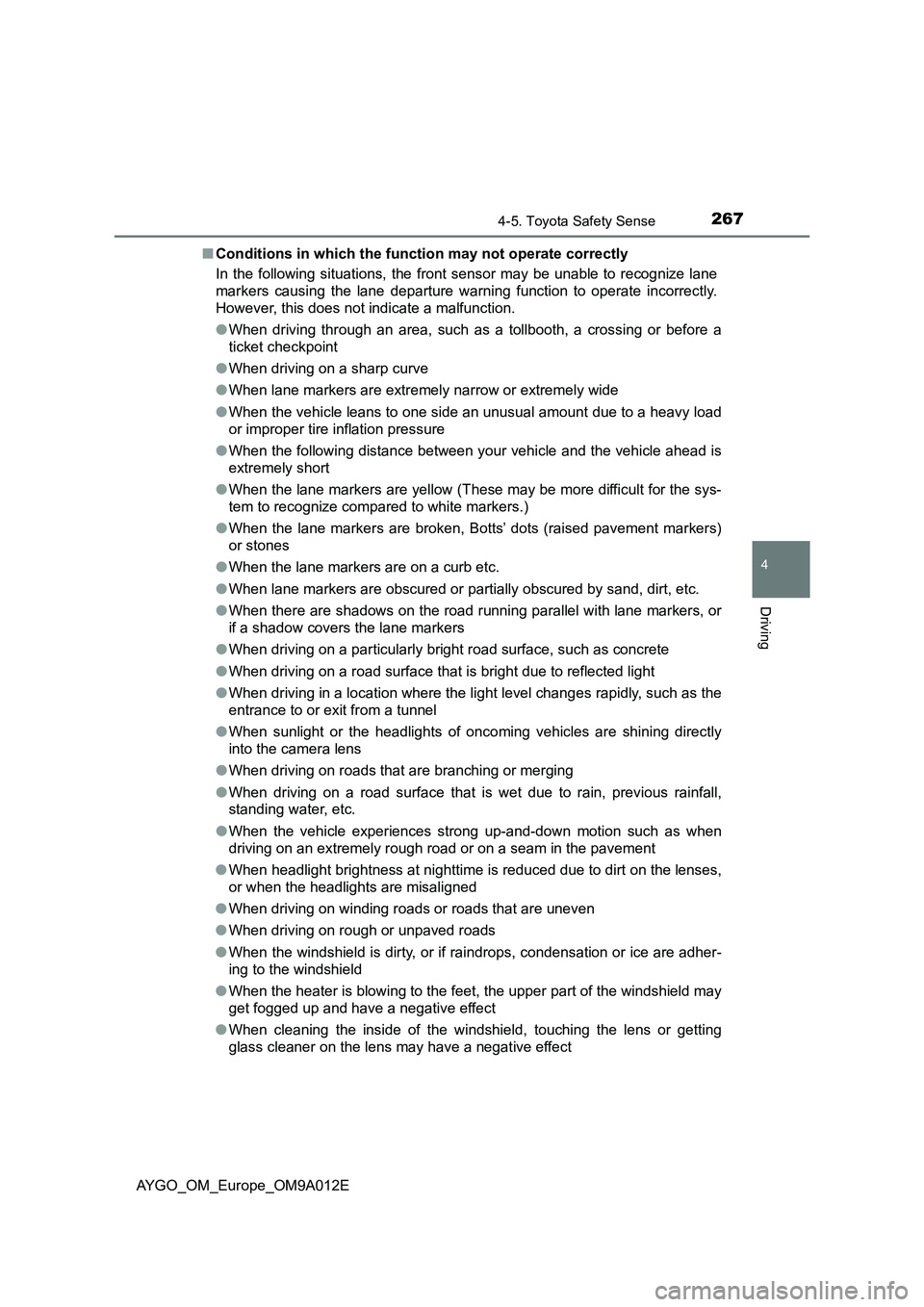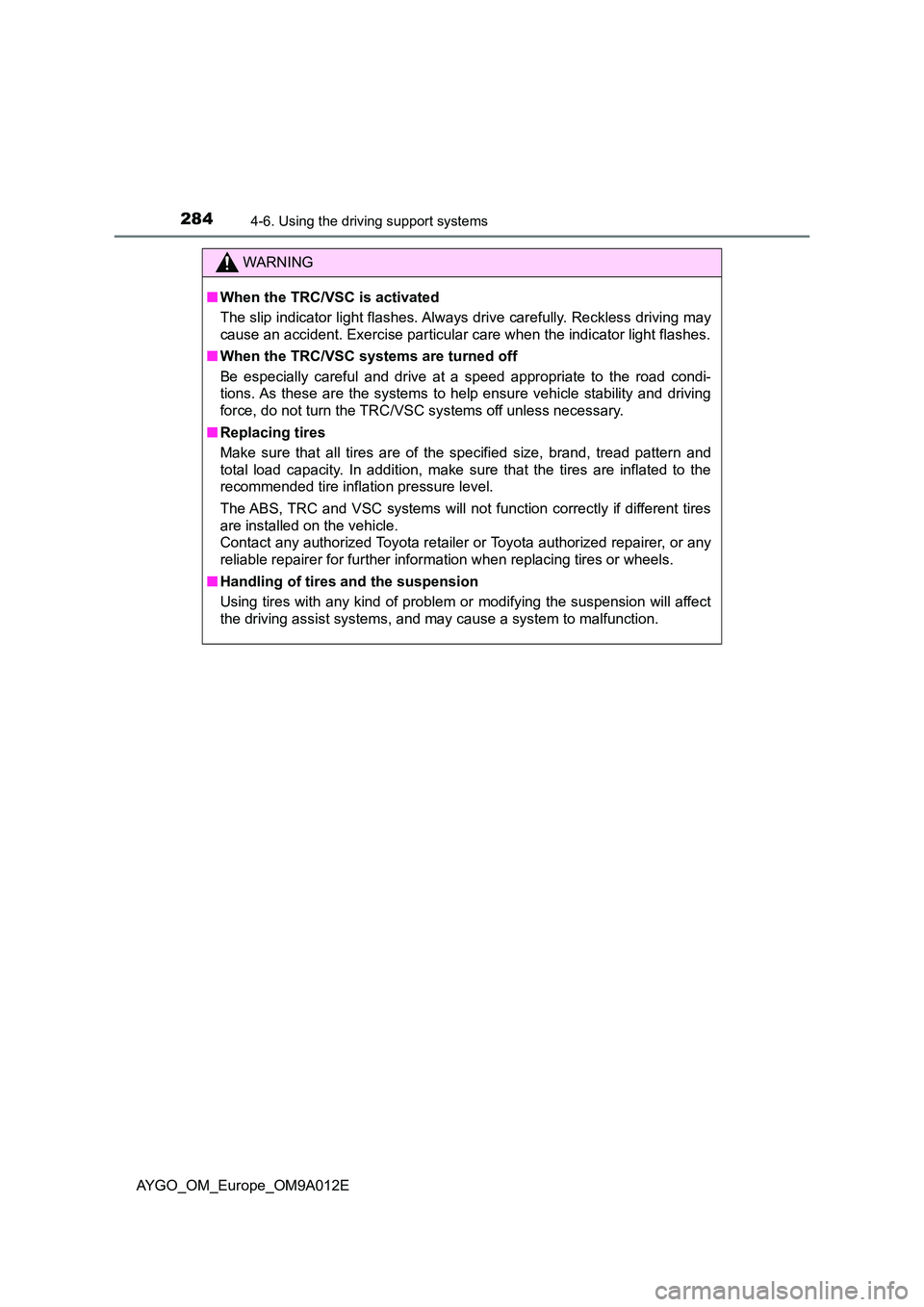2021 TOYOTA AYGO inflation pressure
[x] Cancel search: inflation pressurePage 6 of 546

TABLE OF CONTENTS4
AYGO_OM_Europe_OM9A012E5-8. Bluetooth
® Phone
Making a phone call ...........338
Receiving a phone call.......340
Speaking on the phone ......341
5-9. Bluetooth
®
Bluetooth®.........................343
6-1. Using the air conditioning
system and defogger
Manual air conditioning
system .............................352
Automatic air conditioning
system .............................358
Seat heaters ......................364
6-2. Using the interior lights
Interior lights list .................366
• Interior light ....................366
6-3. Using the storage features
List of storage features ......367
• Glove box ......................368
• Card holders ..................368
• Cup holders ...................368
• Bottle holders ................369
Luggage compartment
features............................371
6-4. Other interior features
Other interior features ........373
• Sun visors ......................373
• Vanity mirrors ................373
• Clock .............................374
• Outside temperature
display ...........................375
• Power outlet ..................3767-1. Maintenance and care
Cleaning and protecting
the vehicle exterior .......... 378
Cleaning and protecting
the vehicle interior ........... 382
7-2. Maintenance
Maintenance
requirements ................... 385
7-3. Do-it-yourself maintenance
Do-it-yourself service
precautions ..................... 387
Hood.................................. 390
Positioning a floor jack ...... 392
Engine compartment ......... 393
Clutch pedal (vehicles
with a manual
transmission .................... 403
Tires .................................. 404
Tire inflation pressure........ 410
Wheels .............................. 412
Air conditioning filter .......... 414
Wireless remote control/
electronic key battery ...... 415
Checking and replacing
fuses ............................... 418
Light bulbs ......................... 426
6Interior features
7Maintenance and care
Page 15 of 546

13Pictorial index
AYGO_OM_Europe_OM9A012EWindshield wiper . . . . . . . . . . . . . . . . . . . . . . . . . . . . . . . . . . P. 237
Precautions against winter season . . . . . . . . . . . . . . . . . . . . . P. 285
Fuel filler door . . . . . . . . . . . . . . . . . . . . . . . . . . . . . . . . . . . . P. 241
Refueling method . . . . . . . . . . . . . . . . . . . . . . . . . . . . . . . . . . P. 241
Fuel type/fuel tank capacity . . . . . . . . . . . . . . . . . . . . . . . . . . . P. 512
Tires . . . . . . . . . . . . . . . . . . . . . . . . . . . . . . . . . . . . . . . . . . . . P. 404
Tire size/inflation pressure . . . . . . . . . . . . . . . . . . . . . . . . . . . . P. 518
Winter tires/tire chain . . . . . . . . . . . . . . . . . . . . . . . . . . . . . . . . P. 285
Checking/rotation/tire pressure warning system
*2 . . . . . . . . . P. 404
Coping with flat tires . . . . . . . . . . . . . . . . . . . . . . . . . . . . P. 459, 481
Hood . . . . . . . . . . . . . . . . . . . . . . . . . . . . . . . . . . . . . . . . . . . . P. 390
Opening . . . . . . . . . . . . . . . . . . . . . . . . . . . . . . . . . . . . . . . . . . P. 390
Engine oil . . . . . . . . . . . . . . . . . . . . . . . . . . . . . . . . . . . . . . . . . P. 512
Coping with overheat . . . . . . . . . . . . . . . . . . . . . . . . . . . . . . . . P. 504
Camera
*2, 3
Headlights . . . . . . . . . . . . . . . . . . . . . . . . . . . . . . . . . . . . . . . P. 231
Front position lights/daytime running lights . . . . . . . . . . . P. 231
Front fog lights
*2/rear fog lights . . . . . . . . . . . . . . . . . . . . . P. 235
Turn signal lights . . . . . . . . . . . . . . . . . . . . . . . . . . . . . . . . . . P. 229
Emergency brake signal . . . . . . . . . . . . . . . . . . . . . . . . . . . . . P. 279
Stop lights
Tail lights . . . . . . . . . . . . . . . . . . . . . . . . . . . . . . . . . . . . . . . . P. 231
License plate lights . . . . . . . . . . . . . . . . . . . . . . . . . . . . . . . . P. 231
Back-up lights
Shifting the shift lever to R. . . . . . . . . . . . . . . . . . . . . . . . P. 222, 227
4
5
6
7
8
Light bulbs of the exterior lights for driving
(Replacing method: P. 426, Watts: P. 520)
*1: Vehicles with a smart entry & start system
*2: If equipped
*3: For vehicles with a multimedia system, refer to “Multimedia owner’s manual”.
9
10
11
12
13
14
15
16
Page 264 of 546

2624-5. Toyota Safety Sense
AYGO_OM_Europe_OM9A012E
• If the wheels are misaligned
• If a wiper blade is blocking the front sensor
• The vehicle is wobbling.
• The vehicle is being driven at extremely high speeds.
• When driving on roads with sharp bends or uneven surfaces
• When a preceding vehicle is a poor reflector of laser
● In some situations such as the following, sufficient braking force may not be
obtained, preventing the system from performing properly:
• If the braking functions cannot operate to their full extent, such as when
the brake parts are extremely cold, extremely hot, or wet
• If the vehicle is not properly maintained (brakes or tires are excessively
worn, improper tire inflation pressure, etc.)
• When the vehicle is being driven on a gravel road or other slippery sur-
face
• If your vehicle is skidding
• When the front part of the vehicle is
raised or lowered
• When the sensor is misaligned due to
a strong impact being applied to the
sensor, etc.
Page 269 of 546

2674-5. Toyota Safety Sense
4
Driving
AYGO_OM_Europe_OM9A012E■Conditions in which the function may not operate correctly
In the following situations, the front sensor may be unable to recognize lane
markers causing the lane departure warning function to operate incorrectly.
However, this does not indicate a malfunction.
●When driving through an area, such as a tollbooth, a crossing or before a
ticket checkpoint
●When driving on a sharp curve
●When lane markers are extremely narrow or extremely wide
●When the vehicle leans to one side an unusual amount due to a heavy load
or improper tire inflation pressure
●When the following distance between your vehicle and the vehicle ahead is
extremely short
●When the lane markers are yellow (These may be more difficult for the sys-
tem to recognize compared to white markers.)
●When the lane markers are broken, Botts’ dots (raised pavement markers)
or stones
●When the lane markers are on a curb etc.
●When lane markers are obscured or partially obscured by sand, dirt, etc.
●When there are shadows on the road running parallel with lane markers, or
if a shadow covers the lane markers
●When driving on a particularly bright road surface, such as concrete
●When driving on a road surface that is bright due to reflected light
●When driving in a location where the light level changes rapidly, such as the
entrance to or exit from a tunnel
●When sunlight or the headlights of oncoming vehicles are shining directly
into the camera lens
●When driving on roads that are branching or merging
●When driving on a road surface that is wet due to rain, previous rainfall,
standing water, etc.
●When the vehicle experiences strong up-and-down motion such as when
driving on an extremely rough road or on a seam in the pavement
●When headlight brightness at nighttime is reduced due to dirt on the lenses,
or when the headlights are misaligned
●When driving on winding roads or roads that are uneven
●When driving on rough or unpaved roads
●When the windshield is dirty, or if raindrops, condensation or ice are adher-
ing to the windshield
●When the heater is blowing to the feet, the upper part of the windshield may
get fogged up and have a negative effect
●When cleaning the inside of the windshield, touching the lens or getting
glass cleaner on the lens may have a negative effect
Page 286 of 546

2844-6. Using the driving support systems
AYGO_OM_Europe_OM9A012E
WARNING
■When the TRC/VSC is activated
The slip indicator light flashes. Always drive carefully. Reckless driving may
cause an accident. Exercise particular care when the indicator light flashes.
■ When the TRC/VSC systems are turned off
Be especially careful and drive at a speed appropriate to the road condi-
tions. As these are the systems to help ensure vehicle stability and driving
force, do not turn the TRC/VSC systems off unless necessary.
■ Replacing tires
Make sure that all tires are of the specified size, brand, tread pattern and
total load capacity. In addition, make sure that the tires are inflated to the
recommended tire inflation pressure level.
The ABS, TRC and VSC systems will not function correctly if different tires
are installed on the vehicle.
Contact any authorized Toyota retailer or Toyota authorized repairer, or any
reliable repairer for further information when replacing tires or wheels.
■ Handling of tires and the suspension
Using tires with any kind of problem or modifying the suspension will affect
the driving assist systems, and may cause a system to malfunction.
Page 379 of 546

377
7Maintenance and care
AYGO_OM_Europe_OM9A012E7-1. Maintenance and care
Cleaning and protecting
the vehicle exterior .......... 378
Cleaning and protecting
the vehicle interior ........... 382
7-2. Maintenance
Maintenance
requirements.................... 385
7-3. Do-it-yourself maintenance
Do-it-yourself service
precautions ...................... 387
Hood .................................. 390
Positioning a floor jack ....... 392
Engine compartment.......... 393
Clutch pedal (vehicles
with a manual
transmission) ................... 403
Tires ................................... 404
Tire inflation pressure ........ 410
Wheels ............................... 412
Air conditioning filter .......... 414
Wireless remote control/
electronic key battery....... 415
Checking and replacing
fuses ................................ 418
Light bulbs ......................... 426
Page 389 of 546

3877-3. Do-it-yourself maintenance
7
Maintenance and care
AYGO_OM_Europe_OM9A012E
Do-it-yourself service precautions
If you perform maintenance by yourself, be sure to follow the
correct procedure as given in these sections.
ItemsParts and tools
Battery condition
(P. 399)•Warm water• Baking soda•Grease
• Conventional wrench (for terminal clamp bolts)
Engine coolant
level (P. 397)
• “Toyota Super Long Life Coolant” or a similar high
quality ethylene glycol-based non-silicate, non-
amine, non-nitrite and non-borate coolant with long-
life hybrid organic acid technology
“Toyota Super Long Life Coolant” is pre-mixed with
50% coolant and 50% deionized water.
• Funnel (used only for adding coolant)
Engine oil level
(P. 394)• “Toyota Genuine Motor Oil” or equivalent
• Rag or paper towel
• Funnel (used only for adding engine oil)
Fuses (P. 4 1 8 )• Fuse with same amperage rating as original
Light bulbs
(P. 426)
• Bulb with same number and wattage rating as origi-
nal
• Phillips-head screwdriver
• Flathead screwdriver•Wrench
Radiator and
condenser
(P. 398)
Tire inflation
pressure
(P. 410)• Tire pressure gauge
• Compressed air source
Washer fluid
(P. 402)• Water or washer fluid containing antifreeze (for win-
ter use)
• Funnel (used only for adding water or washer fluid)
Page 407 of 546

4057-3. Do-it-yourself maintenance
7
Maintenance and care
AYGO_OM_Europe_OM9A012E
■When to replace your vehicle’s tires
Tires should be replaced if:
●The treadwear indicators are showing on a tire.
●You have tire damage such as cuts, splits, cracks deep enough to expose
the fabric, and bulges indicating internal damage
●A tire goes flat repeatedly or cannot be properly repaired due to the size or
location of a cut or other damage
If you are not sure, consult with any authorized Toyota retailer or Toyota
authorized repairer, or any reliable repairer.
■Tire life
Any tire over 6 years old must be checked by a qualified technician even if it
has seldom or never been used or damage is not obvious.
■Low profile tires (vehicles with 165/60R15 tires)
Generally, low profile tires will wear more rapidly and tire grip performance
will be reduced on snowy and/or icy roads when compared to standard tires.
Be sure to use snow tires or tire chains on snowy and/or icy roads and drive
carefully at a speed appropriate for road and weather conditions.
■If the tread on snow tires wears down below 4 mm (0.16 in.)
The effectiveness of the tires as snow tires is lost.
Your vehicle is equipped with a tire pressure warning system.
While the vehicle is in motion, the system monitors the fluctuations in
the wheel speed signals that are output by the speed sensor for the
brake control system.
It informs the driver if it detects a low tire inflation pressure.
◆Initializing the tire pressure warning system
■The tire pressure warning system must be initialized when
changing the tire
When the tire pressure warning system is initialized, the current tire
inflation pressure is set as the benchmark pressure.
■The initialization operation
●Make sure to carry out initialization after adjusting the tire infla-
tion pressure. Also, make sure the tires are cold before carrying
out initialization or tire inflation pressure adjustment.
●If you accidentally press the reset switch when initialization is not
necessary, adjust the tire inflation pressure to the specified level
when the tires are cold, and conduct initialization again.
Tire pressure warning system (if equipped)